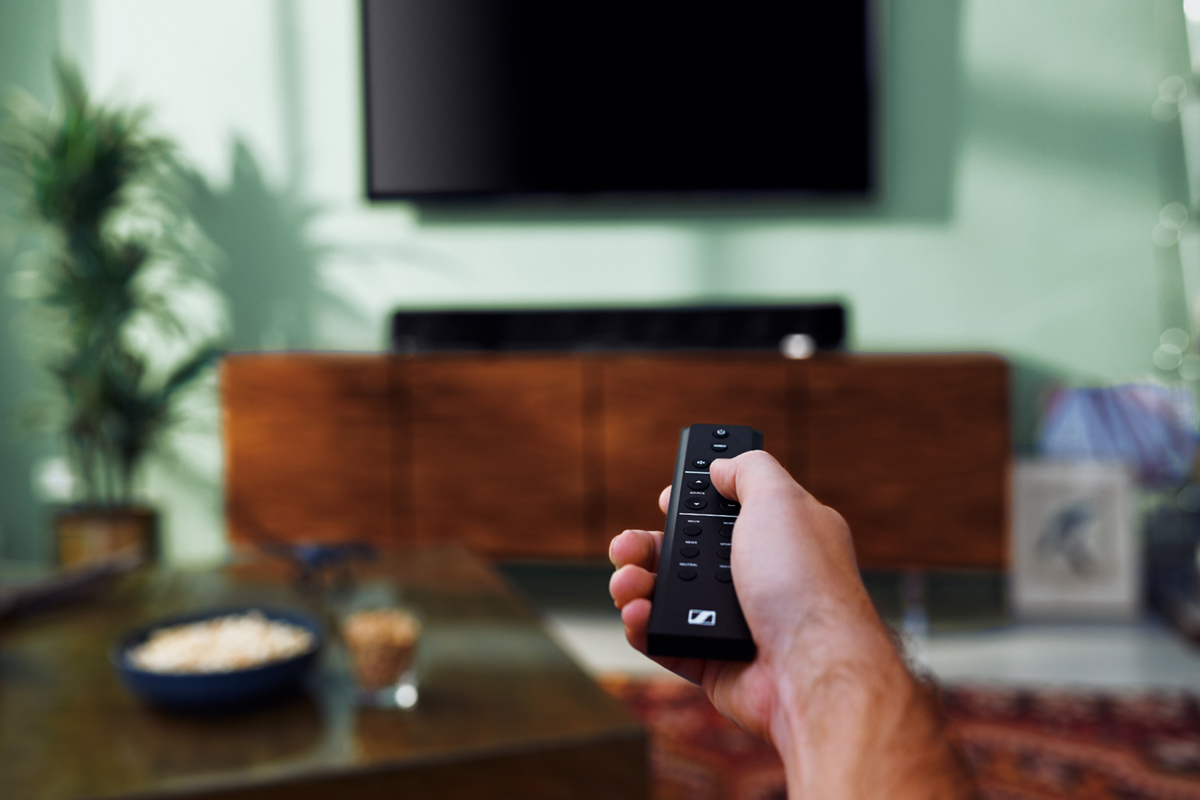Is there a hobby that’s less domesticated than home theater? Ever since people began connecting their TVs to their stereos in the late 1970s, audio manufacturers have been encouraging them to add more and more speakers -- and it’s gotten a bit crazy.
First came Dolby Surround, which required adding two speakers to the standard stereo pair, for surround effects. For Dolby Digital and DTS, which arrived in the mid-1990s, about the same time as the DVD, you needed to add a center-channel speaker and at least one subwoofer. Dolby Digital Surround EX added two more surround channels, for both the sides and the rear of the room.
New immersive audio formats such as Dolby Atmos and DTS:X have further upped the ante, calling for two or four additional speakers to produce overhead sound effects. A full-blown immersive system can have as many as 11 full-range speakers, and one or more subwoofers. While these systems can deliver amazing experiences, you need a lot of room for them -- ideally, a dedicated home theater. But for multipurpose living areas, they’re a bit insane.
The reaction to this excess has been the soundbar, but these require compromises. While premium models such as DALI’s Katch One ($999, all prices USD) deliver very satisfying sound for both movies and music, many mass-market soundbars have a strident character that can impress at first but that quickly becomes fatiguing. Moreover, most soundbars, including the Katch One, have only two or three channels, plus some circuitry for adding spatial effects -- they don’t deliver true surround sound.
Sennheiser’s Ambeo soundbar ($2499.95) is a much more ambitious product. It purports to deliver room-filling immersive audio from a single enclosure that can fit on a shelf below a flatscreen TV, or be mounted on the wall, using its optional SB01-WM wall bracket ($59.95). Using virtualization technology developed at Germany’s Fraunhofer Institute, the Ambeo processes signals to make it seem as if sounds are coming from above and beside the listener, not just in front.
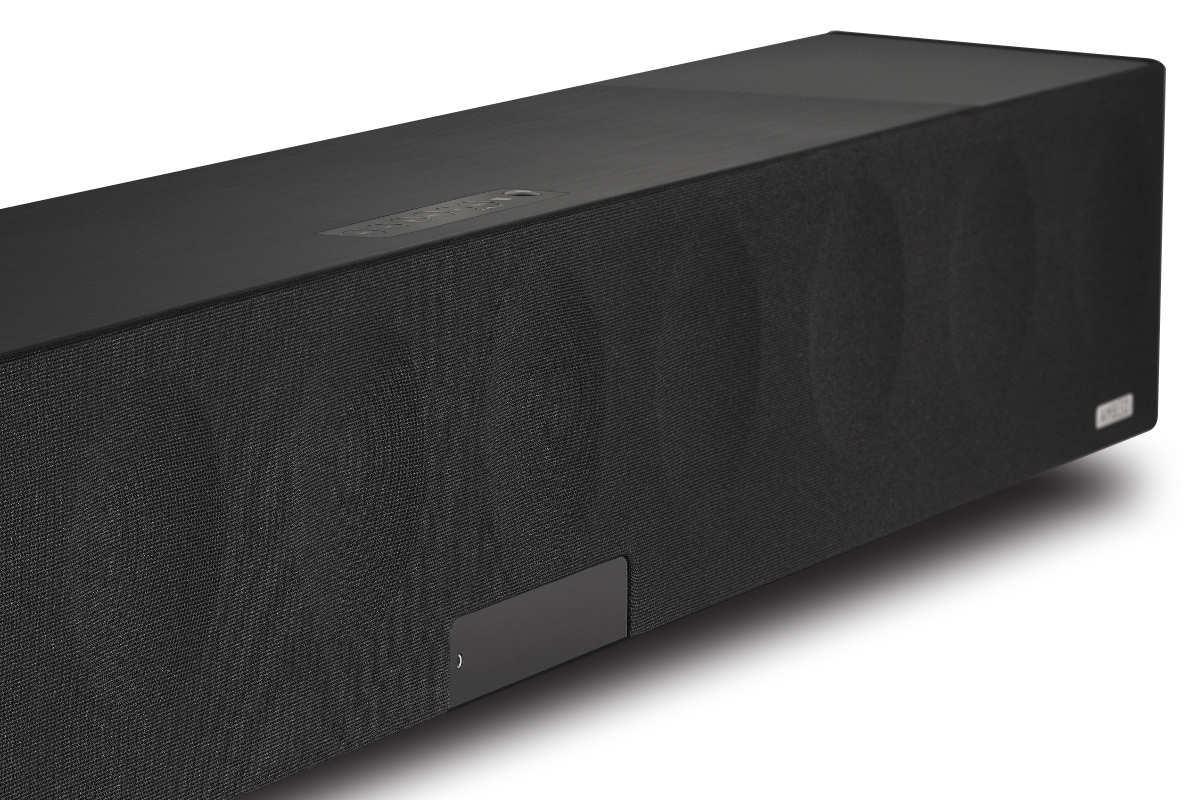
Is this psychoacoustic trickery effective? The members of the Expert Imaging and Sound Association (EISA) think so. Last summer, they awarded the Ambeo soundbar an EISA 2019-2020 Award for Best Premium Soundbar, noting that it “has effectively rewritten the immersive audio rulebook.”
The Ambeo can also be used for music. It has optical S/PDIF and RCA analog inputs, as well as Bluetooth, Chromecast Built-in, UPnP streaming, and Ethernet and Wi-Fi networking (with support for 802.11ac).
Surround 101
Before explaining how Sennheiser’s Ambeo soundbar fools listeners into hearing sounds from all around the room, it’s worth explaining what immersive audio is, and how it differs from traditional channel-based surround sound. This will be familiar fare to some readers, who can skip ahead to the next section.
In home applications, a Dolby Atmos system can have five or seven “floor” speakers, just as in a Dolby Digital or Dolby Digital Plus system: front left, right, and center, plus two or four surround speakers. The “floor” speakers don’t have to be on the floor -- the adjective is meant to convey that they’re at or close to ear level. Dolby Digital and Dolby Atmos soundtracks have a low-frequency effects (LFE) channel that’s almost always played through a subwoofer -- the “.1” part of the numerical description. So far, this sounds like standard 5.1- and 7.1-channel surround sound.
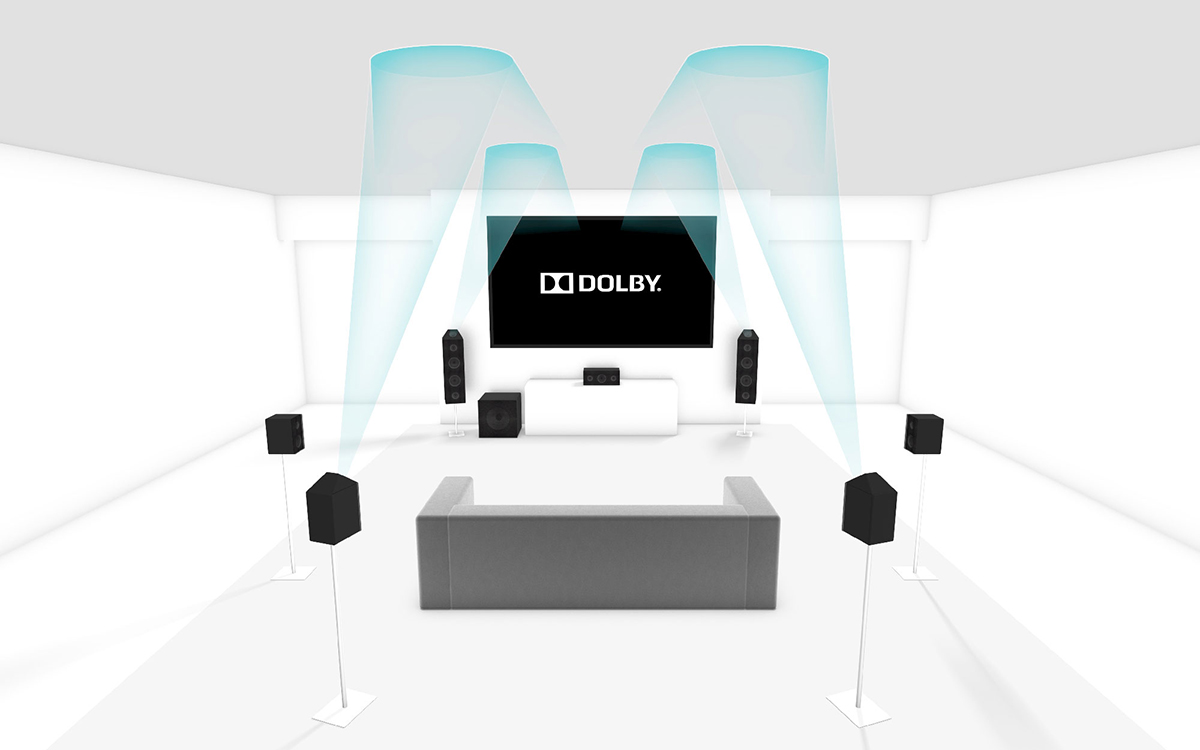
As noted, Dolby Atmos home-theater systems also have two or four speakers for height effects. These can be speakers mounted on or in the ceiling, or upward-firing “Atmos-enabled” speakers, which are usually placed atop the floor speakers. Atmos-enabled speakers bounce sounds off the ceiling -- combined with some DSP-enabled psychoacoustic trickery, this creates the illusion of sound coming from above.
The height speakers mean that an additional number is needed to describe the layout of an immersive audio system. A 5.1.4 (pronounced five-dot-one-dot-four) system has five floor speakers (front left, right, and center, and two surrounds), one subwoofer, and four height-effects speakers, either Atmos-enabled or ceiling-mounted. A 7.2.2 system has seven floor speakers (front left, right, and center, and four surrounds), two subwoofers, and two height-effects speakers. The diagram above shows a 7.1.4 system that employs upward-firing, Atmos-enabled, height-effects speakers. There are other variants, but you get the picture.
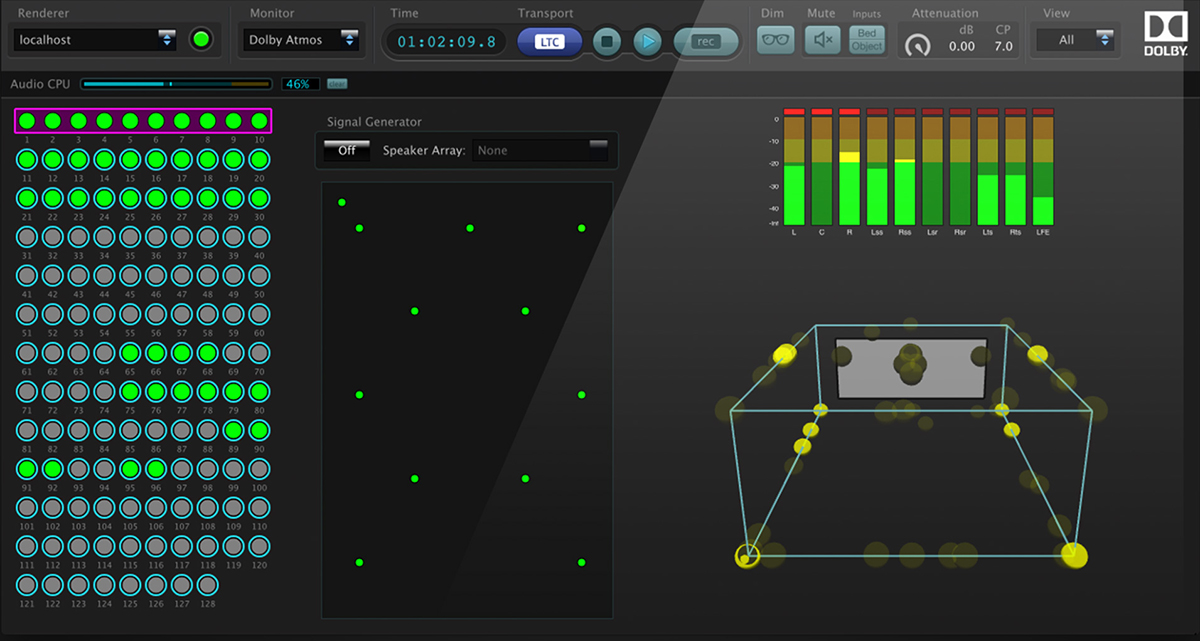
A Dolby Atmos soundtrack can have up to 128 separate tracks. These can be assigned to any of the seven floor channels, or mixed between them and panned about, just as with traditional channel-based surround formats like Dolby Digital and DTS. But sounds can also be treated as objects -- that is, the sound engineer can use a digital audio workstation to specify their positions in a three-dimensional soundfield, and move them about as desired. The position of the object at any given moment is stored as metadata. In playback, the Dolby Atmos processor uses that metadata to map those objects to the specific speaker layout in the listening room.
Other object-based surround formats include DTS:X, MPEG-H, and Aura 3D. While their details differ, the overall principles are broadly similar to those used in Dolby Atmos.
Most discussions of object-based immersive formats focus on height effects -- the way they can portray such sounds as falling rain and aircraft flying overhead. But there’s another major benefit that’s less frequently discussed: spatial unmasking. Combined with the extra height speakers, object-based surround permits a near-infinite number of virtual positions for sound objects. Thanks to spatial unmasking, individual sounds are better differentiated, rather than being mixed into a big mush.
Inside and out
Sennheiser claims that its Ambeo soundbar “delivers a 5.1.4” experience” with Dolby Atmos, DTS:X, and MPEG-H content. It can also upmix 5.1-channel and two-channel content to 5.1.4. Moreover, Sennheiser claims that the Ambeo can produce bass output down to 30Hz without a subwoofer. Its specified frequency response is 30Hz-20kHz, -3dB. Essentially, the Ambeo is a self-contained, 5.1.4-channel immersive audio system that can fit on a shelf (or, in my room, a fireplace mantle) or be mounted on the wall.
In the front center of the top panel is a group of seven buttons, for Mute, Volume Down and Up, Ambeo mode (to activate upmixing or room calibration), a multifunction button for controlling media playback, Source (press these last two simultaneously for Bluetooth pairing), and On/Off. In the lower center of the front panel are information and status displays, plus a 2.5mm jack for the calibration microphone; at far right, an Ambeo logo is backlit when the Ambeo mode is activated.
The jack pack at the bottom of the rear panel has a two-prong IEC power inlet, three HDMI 2.0a inputs, one HDMI 2.1a output with support for Extended Audio Return Channel (eARC), an Ethernet port, a USB port (firmware updates only), a pair of analog audio inputs (RCA), a TosLink input, and a subwoofer output (RCA). The HDMI ports can pass along 4K and Dolby Vision ultra-high-definition images.
The Ambeo is a substantial piece of kit, weighing 40.8 pounds (five times as much as DALI’s Katch One), and measuring 49.8”W x 5.3”H x 6.7”D (including feet). On the front panel of the impressively inert brushed-aluminum enclosure are six front-firing, 4”, long-throw woofers and three 1” aluminum-dome tweeters: one on either side of the front panel and one in the center, all three firing to the front; two more such tweeters are on the angled left and right side panels, firing to the side. Completing the driver complement are two 3.5” upward-firing full-range drivers, one each at the far left and right ends of the top panel.
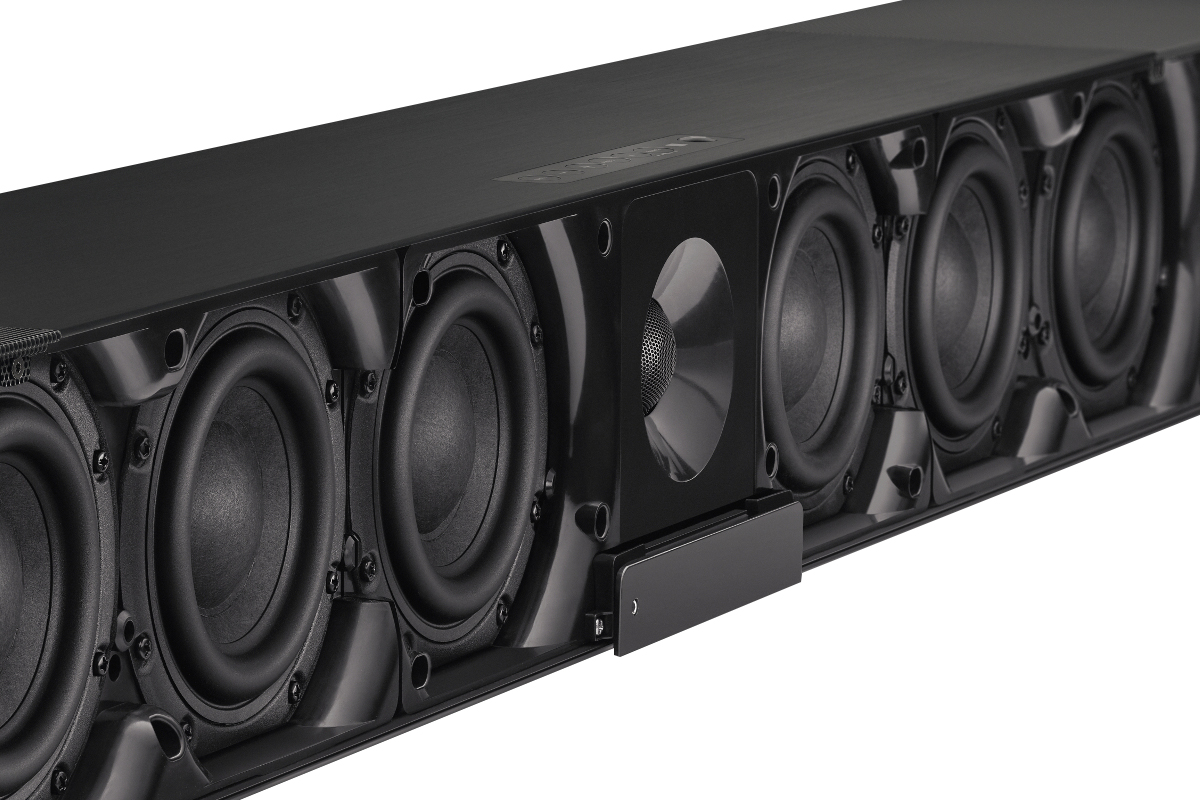
The build quality is exemplary, the styling classy and understated -- the point likely being that viewers’ eyes should be drawn to the pictures on the screen, not the speaker on the mantle. All drivers are covered with grilles: black cloth for the front and side drivers, metal for the top drivers.
Inside the Ambeo are two digital signal-processing (DSP) chips. The first is used to decode Dolby Atmos, DTS:X, and MPEG-H streams and process them for 5.1.4 output. The second chip processes the 5.1.4 content to suit the Ambeo’s driver configuration and the listening environment, and feeds seven Texas Instruments TAS3251 DAC-class-D amplifier modules, each specified to output 140Wx2 into 4 ohms at 1% THD+noise. The Ambeo is fully active, with a dedicated amplifier for each driver. Sennheiser specifies its total maximum output as 500W.
The Ambeo supports pretty well every surround codec under the sun -- not only the Dolby Atmos, DTS:X, and MPEG-H immersive codecs, but such HD surround codecs as Dolby TrueHD and DTS-HD MA, and older codecs: Dolby Digital, Dolby Digital Plus, and DTS. Via Chromecast, the maximum resolution is 24-bit/48kHz PCM. When streaming to the Ambeo via UPnP, the maximum resolutions are 24/192 PCM and DSD64.
Included with the Ambeo is a solid-feeling remote control with On/Off, Volume, Mute, and Source buttons, an Ambeo button for activating virtual surround processing, and five buttons for the soundbar’s preset sound profiles: Movies, Music, Neutral, News, Sports. Also included are a power cord, a high-speed HDMI cable (2m), a Quick Guide, and a calibration microphone premounted on a short stand.
The Quick Guide is well laid out and clearly written, but some topics, such as Wi-Fi setup and Chromecast, are covered only in passing. A more thorough manual is available on Sennheiser’s website.
Setup
I installed the Ambeo on the mantle of our faux fireplace, below our 55” Samsung Frame TV. All of the Frame’s inputs and outputs are housed in a companion One Connect Box, which feeds video to the panel via a superthin, 5m-long fiber-optic cable.
I connected an Apple TV 4K media player and Samsung UMB-M7500 Ultra HD BD player to two of the Ambeo’s HDMI inputs, and the soundbar’s output to the ARC-enabled HDMI input on the Frame TV’s One Connect Box. This arrangement let me send video from the Apple TV and Samsung BD player to the Frame TV, and play audio from the Frame TV’s smart-TV apps and TV tuner through the Ambeo.
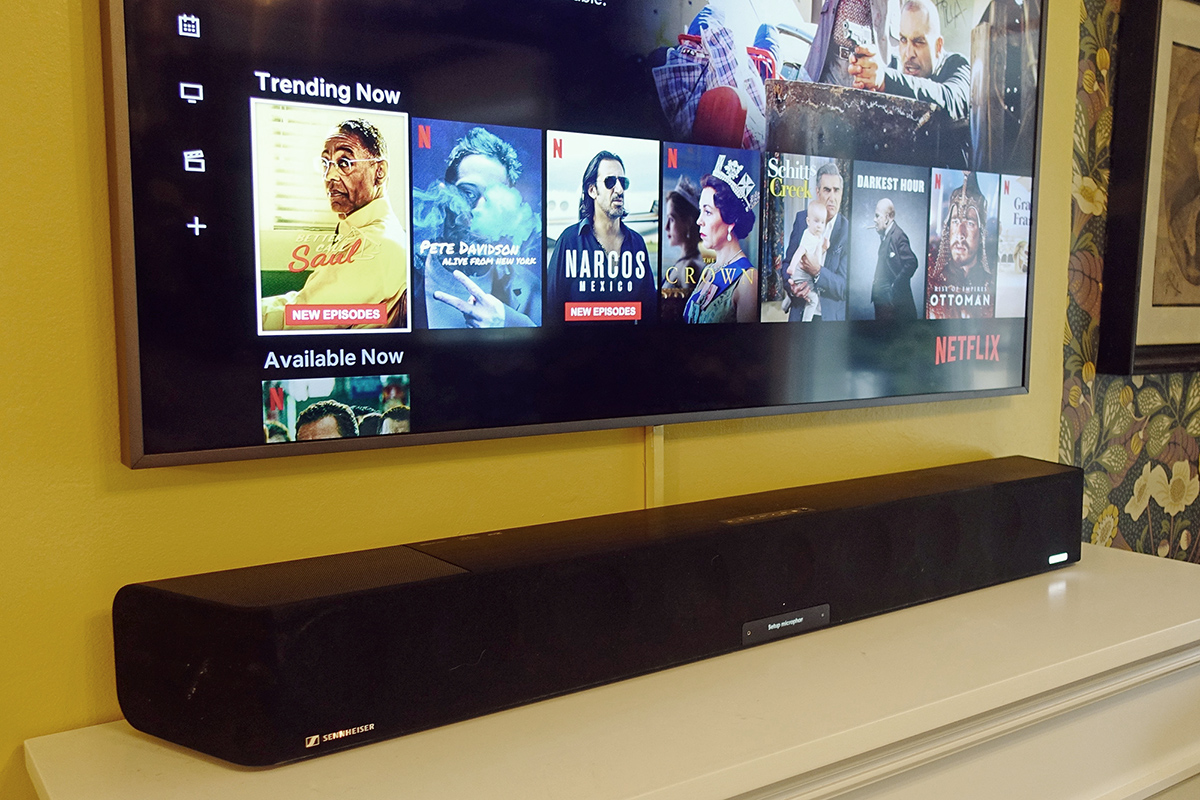
Theoretically, I could have left the Samsung and Apple players connected to the Frame TV’s One Connect Box, and sent audio from those sources to the Ambeo via HDMI-ARC. My Frame TV dates from 2017 and doesn’t support eARC, so can’t send immersive audio bitstreams via HDMI-ARC. That’s why I connected those sources directly to the soundbar.
Important: To get true surround sound from your TV’s apps and tuner, you need to configure your TV’s sound menus to send some form of bitstream audio, rather than LPCM, over HDMI-ARC. I set the Frame TV’s sound menu to output Dolby Digital Plus via HDMI-ARC.
Sennheiser recommends that the Ambeo be installed at least 4” (10cm) below the TV to allow room for ventilation, and at least 6.5’ (2m) from the primary listening position. Ideally, the soundbar should be equidistant from the major room boundaries -- i.e., the distances from the top of the soundbar to the ceiling, from the left edge of the soundbar to the left sidewall, and from the right edge of the soundbar to the right sidewall, should all be the same. Per the Guide, that distance can be anywhere from 1 to 5m (3.3’ to 16.4’).
Of course, it’s hard to achieve that kind of symmetry in most multi-use living spaces, and in ours I got only partway there. The distances from the top of the soundbar to the ceiling, and from the right edge to the right sidewall, were the same: 55”. But to the left of the TV and soundbar is an archway that opens up into our dining room, which meant that the distance to the left sidewall was over 15’. The distance from the Ambeo’s front baffle to my primary listening position was 9’.
The first time I powered up the Ambeo, a message on its display instructed me to connect the microphone and then, after placing it in the main listening position (the end cushion of our sectional sofa, directly in front of the TV), to press the Ambeo button on the soundbar or remote to begin calibration. After then telling me to step aside, the display counted down ten seconds, after which the soundbar emitted a series of sweeps. These ended a few minutes later, and the display instructed me to again press Ambeo to finalize calibration. Interestingly, the calibration process takes measurements at only a single listening position.
If you’re using a subwoofer, it should be connected and turned on during the calibration process, with the crossover frequency control at its highest setting. That’s because the Ambeo handles all aspects of bass management. If you add a sub later on, you have to repeat the calibration process.
Calibration is vital, because the Ambeo’s processors use this information to tailor sound to the listening environment. Its second DSP chip creates virtual surround through a beamforming process. To create surround effects, it sends the same sounds to different drivers with various time delays. Because of the interference between the output of the different drivers, sound is directed to a room boundary and reflected back to the listener, making it seem as if that sound is coming from above or the side. The DSP performs other functions as well, including crossover filtering, driver EQ, room EQ, user EQ, bass management, and dynamic limiting.
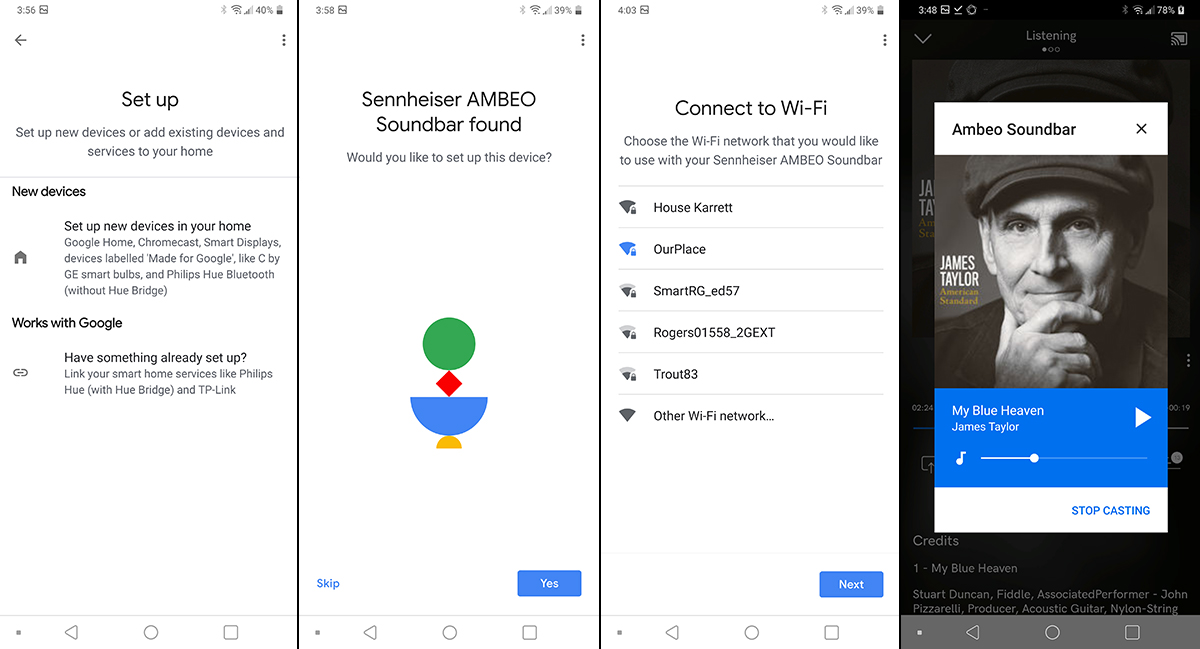
I wanted to connect the Ambeo to my Wi-Fi network so that I could stream music to it via Chromecast. The process, described in the Google Chromecast section of my March 1 feature, “Rules of the Game,” is pretty easy. First, you need to install the Google Home app on your iOS or Android device, then create a “home” and give it a nickname. After that, you can add your Chromecast device to your home and assign it to a room.
I already had Google Home on my LG G7 ThinQ smartphone, and had created a home: BrockHouse. I clicked the + button in the upper-left corner of the home screen, and in the Add and Manage screen that followed, selected Set up Device. Google Home recognized the Ambeo and asked me to give it a name, assign it to a room, and confirm the name of my home network. The app then uploaded my network password to the Ambeo and connected it to my home network. Now I was able to cast audio to the soundbar from any Cast-enabled app on any device on my home network.
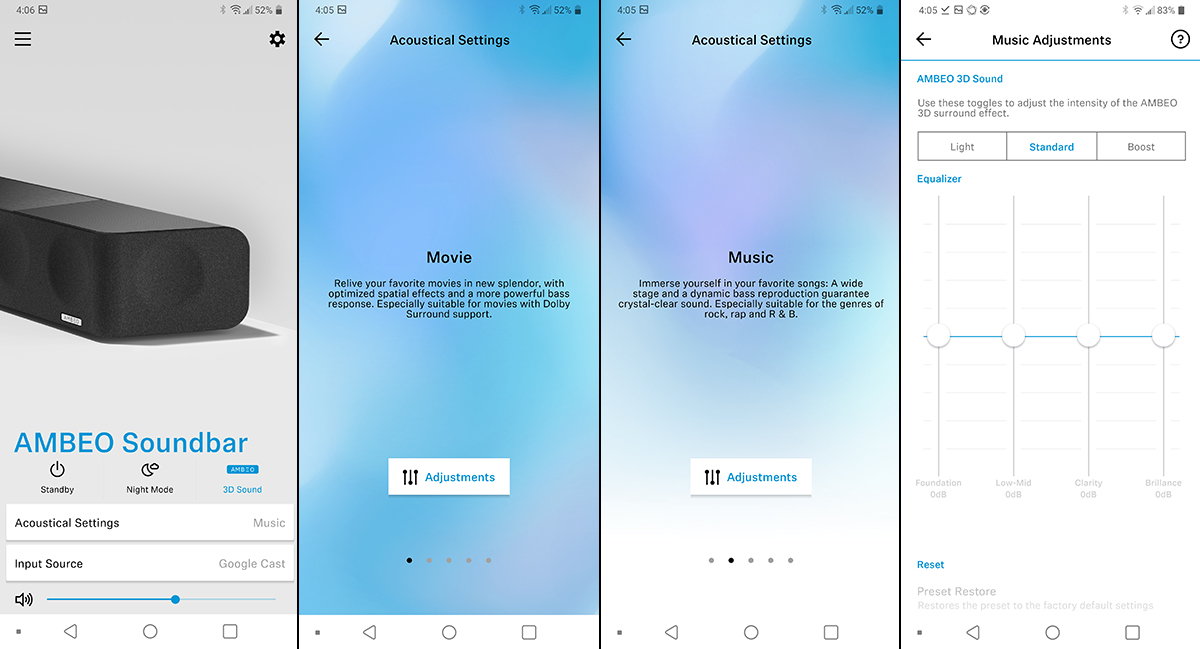
The last step was to download the Ambeo Smart Control app. This lets you select sources, adjust volume, and cycle among the five sound profiles, which you can also do with the remote control. But unlike the remote, Smart Control lets you control the intensity of each sound profile (the options are Light, Standard, and Boost), and adjust a four-band equalizer for each profile. I left the EQ settings flat and, after experimenting with the intensity settings, settled on Standard. Per recommendations in the Smart Control app, I used the Movie profile for movies and TV, Music for popular music, and Neutral for acoustic jazz and classical.
It was showtime.
Movies and TV
Several characteristics were consistent throughout my listening:
While not visceral or chest-pounding, the Ambeo’s bass was impressive for a soundbar: deep, robust, well controlled. Fans of big sci-fi and action flicks might want to add a sub. For other genres, the Ambeo’s bass output is definitely satisfactory.
With both movies and music, dynamics were the most impressive I’ve ever heard from a soundbar. The Ambeo Soundbar could play really loud without losing its composure.
With Dolby Atmos and upmixed 5.1-channel content, the Ambeo created a huge, immersive soundfield that extended far out into the room, far off to the sides, and well above the TV screen. The sense of the spaces portrayed on the screen was compelling.
Individual surround effects were well positioned on the right side of room, more diffuse on the left. I suspect this had to do with my room layout.
When I moved to the side, surround effects were much less dramatic than they were from the sweet spot; when I sat 30° off axis, the soundfield collapsed into the area around the soundbar.
From the sweet spot directly in front of the TV, vocal and instrumental timbres were commendably neutral. As I shifted to the side, dialog became slightly hollow, then obviously so by 30° off axis. When I asked Sennheiser about this, they said, “Yes, if the listener moves off-axis, the sound becomes a bit hollow. This is due to the waveguided high frequencies from the tweeter.”
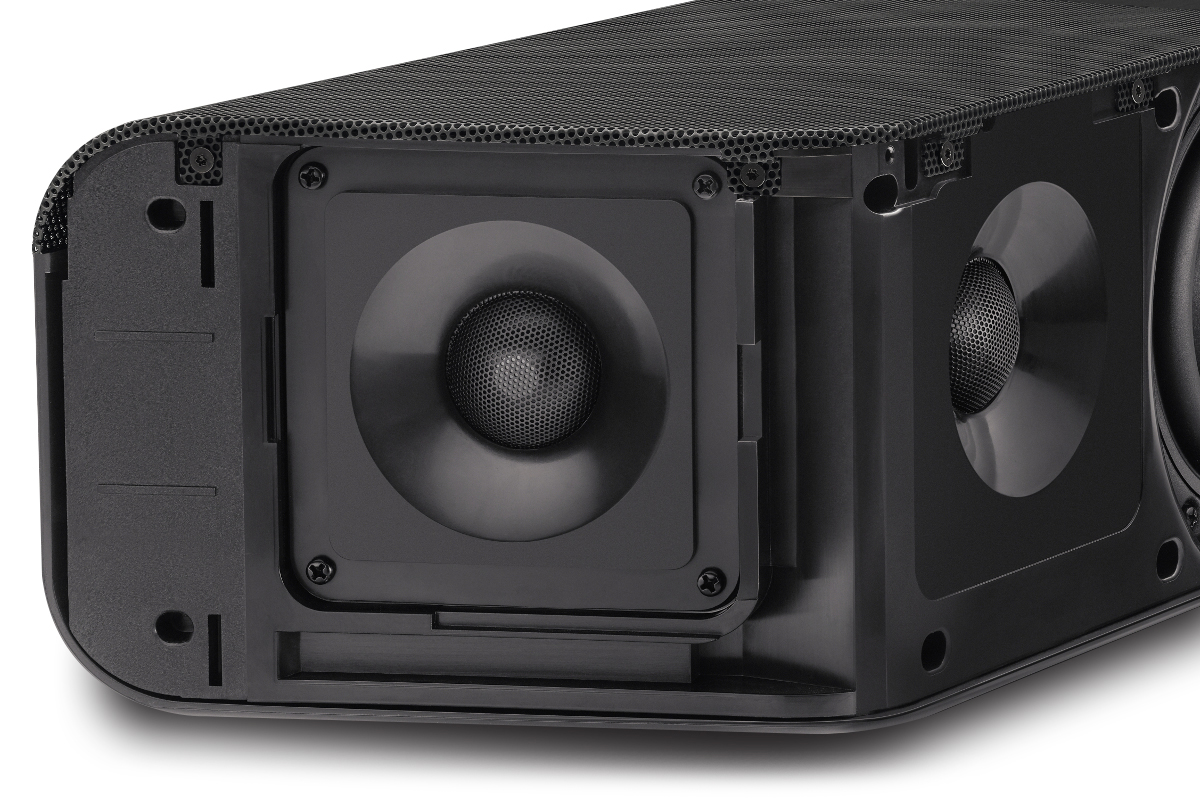
One of the first shows I watched was the second episode of the first season of Better Call Saul, via Netflix. The Netflix app on my Samsung Frame TV sent a 5.1-channel Dolby Digital Plus stream to the Ambeo. Dialog sounded excellent -- accurate, intelligible, and accurately tied to the screen. Environmental effects and crowd sounds -- for example, in the courthouse where the lead character, Jimmy McGill (Bob Odenkirk), acts as a public defender -- were very impressive, extending far to the sides and way out into my living room. Where appropriate, effects remained tied to the screen; e.g., when Jimmy pulls out the day bed in his cramped office in the back of a nail salon.
To hear how the Ambeo would perform with a recent Dolby Atmos soundtrack, I rented the ultra-hi-def version of Joker from the iTunes store and streamed it to my Apple TV 4K. Hildur Guðnadóttir’s haunting score spread way out into the sides of my room, and double basses, synths, and bass drums had great depth. The Ambeo convincingly portrayed the big, grimy, urban spaces depicted -- chaotic city sounds came from all over the room, sounding natural but also somewhat diffuse, as they do in real life. Equally convincing were effects in cramped spaces, such as slammed doors reverberating down the hall of the tenement building where the lead character, Arthur Fleck (Joaquin Phoenix), lives with his mother.
From the sweet spot on my sofa, the pivotal subway scene, in which Arthur murders three obnoxious stockbrokers, was hugely effective. The sounds of the train rattling down the tracks and echoing through tunnels filled my room -- it was like being in a subway. When Arthur kills the third stockbroker as he attempts to escape, the reverberation of the gunshots through the subway station extended far out into my room in every dimension, the echoes seeming to follow the trajectory of the shots.
I heard all of this while sitting in the sweet spot on our sofa, directly in front of the screen. I then shifted to a small armchair 4’ to the left, which put me about 30° off axis -- the effects collapsed to a small area around the soundbar, and dialog became somewhat hollow.
For a Friday-night movie during the review period, I played the Ultra HD BD of The Fifth Element: 20th Anniversary Edition on my Samsung UMB-M7500. In the dramatic scene in which the ex-commando Korben Dallas (Bruce Willis) helps the female Supreme Being, Leeloo (Milla Jovovich), escape from the police in his flying taxi, the soundscape created by the Ambeo was wonderfully expansive, flying cars zooming in and out from the sides, above, and far into the room.
The spaceport scene, in which the key characters vie to get on a spaceship bound for the vacation planet Fhloston Paradise, was also fantastic. Through the Ambeo, random crowd and environmental sounds emerged from seemingly everywhere, just as they would in a busy airport or train station.
In the climactic concert and battle scenes on Fhloston Paradise, I admired the singing voice of the blue alien Diva (Maïwenn) as she performs an aria that morphs into a rocking number, its timing matching a fight between Leeloo and the dog-eared Mangalore aliens. The sonic portrayal of the concert hall was impressively expansive. So were the battle scenes that followed, bullets ricocheting all around my room. While the positioning of these sounds lacked laser-like accuracy, it was still pretty impressive. Again, these effects collapsed when I moved far off axis.
Music
To assess the Ambeo’s musical capabilities, I streamed several CD-resolution and hi-rez albums via Chromecast, as well as some YouTube concerts and music videos.
Two tracks from I’m New Here, the extraordinary final album of the late American musician-poet Gil Scott-Heron (16/44.1 FLAC, XL/Qobuz), showed off different aspects of the Ambeo. Scott-Heron’s work encompasses soul, blues, jazz, and hip-hop, and his cover of Robert Johnson’s “Me and the Devil” has elements of all of those genres. With Ambeo upmixing and the Music sound profile enabled, the screeching industrial effects and big hip-hop drums jumped out into my room, hitting way harder than anyone would expect from a soundbar. This re-created in sound the gritty, dystopian atmosphere so compellingly visible in the music video, which I later watched on YouTube. Scott-Heron’s angry, weary, bluesy vocals, half sung, half recited, were profoundly affecting.
The title track, composed by Bill Callahan, was a complete contrast: Scott-Heron’s voice accompanied only by Pat Sullivan’s finger-picked chords on acoustic guitar. Both sounded very natural through the Ambeo, but the soundscape was somewhat confined -- perhaps because this track didn’t give the Ambeo processor a lot to work with.
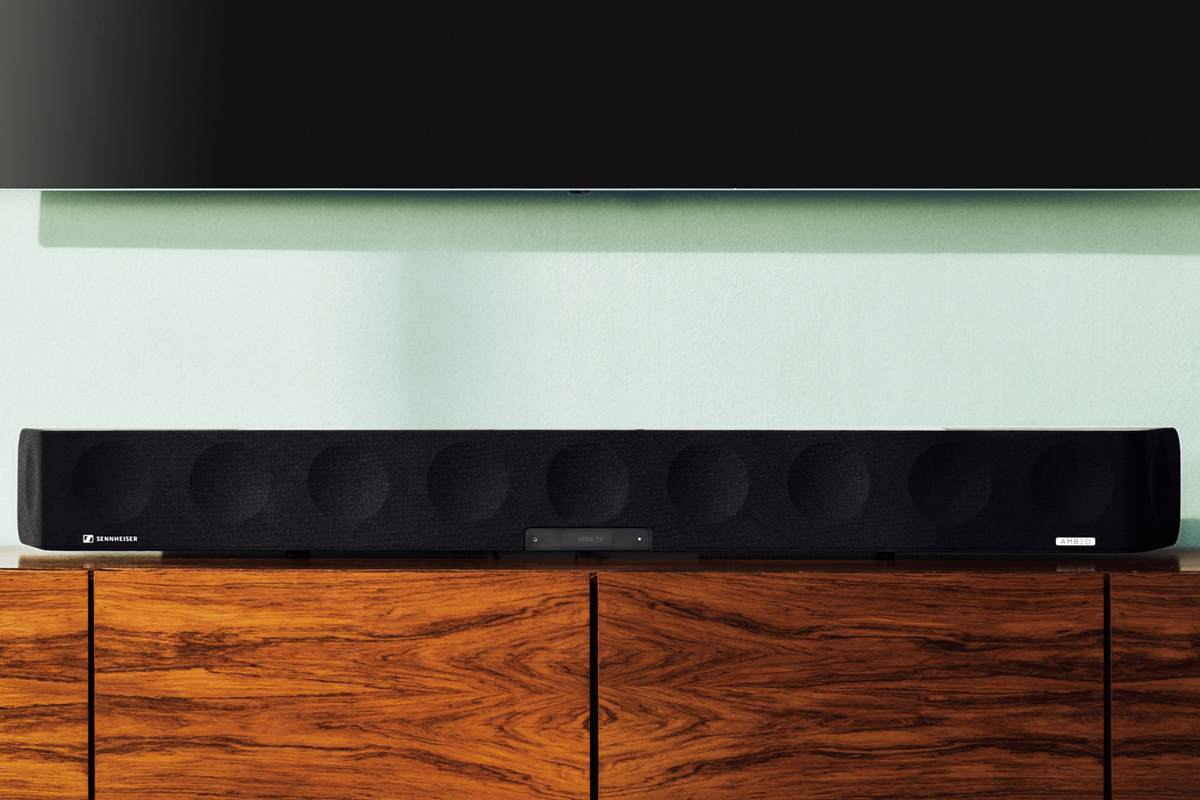
Ambeo upmixing, now set to the Neutral sound profile, proved very effective with a new recording of Books I and II of J.S. Bach’s Well-Tempered Clavier by the French-born, US-based pianist George Lepauw (24/48 FLAC, Orchid Classics/Qobuz). Lepauw recorded the five-hour set over five days in the Jakobskirche, the oldest church in Weimar, Germany, the city where Bach spent most of his early career, and where he composed Book I of the WTC.
On the album’s official website is a half-hour documentary accessible to purchasers of the set, and including footage of Lepauw performing in the Jakobskirche. With Ambeo upmixing enabled, the soundbar created a convincing facsimile of the space shown in the documentary: it’s huge. With Ambeo turned off, the soundstage collapsed to the soundbar itself, so that it sounded like a very good tabletop music system. While impressive for a soundbar, the reproduction of the sound of Lepauw’s instrument, a big Steinway concert grand, wasn’t as big or as authoritative as I would have liked. In the upper register, I found transients a little soft.
Comparison
I didn’t have another soundbar on hand for this review, so I compared the Ambeo with my reference system: an NAD Classic C 658 streaming DAC-preamp ($1649) connected to a pair of Elac Navis ARF-51 active speakers ($4599.96/pair). For this comparison, I enabled the C 658’s Dirac Live room correction, reasoning that the Ambeo also performs some kind of room EQ.
This comparison might seem outlandish, but there’s method to my madness. The NAD-Elac combination is representative of the kind of system someone might buy to get “convenient, lifestyle-oriented hi-fi” in a living space like ours -- an open-concept living-dining room in a small urban rowhouse -- if the purchaser’s first priority is music. I can say that with confidence, because that’s what I bought! But someone whose first priority is movies, and who wants a low-footprint system that can produce enveloping surround sound in a small multipurpose space and will also perform well with music, might well opt for something like Sennheiser’s Ambeo.
That’s exactly what this comparison confirmed. The dialog in Joker sounded more neutral through the Elac-NAD combo. And unlike the Ambeo, with the Elacs dialog did not become hollow as I moved off axis. In Hildur Guðnadóttir’s score, cellos and violins sounded woodier, warmer, richer, more rosiny, and more embodied through the Elacs. The huge timpani beat, played as the inwardly transformed Arthur Fleck leaves the public washroom following the subway murders, sounded way bigger through the Elacs. On the other hand, through the Ambeo, the music extended farther laterally and vertically.
Effects such as gunshots and subway trains sounded deeper, more dynamic, and less grating through the Elacs. By comparison, the Ambeo had a slight tearing, strident quality. But through the Elacs, effects were more tied to the speaker plane -- they didn’t extend out into the room nearly as far as with the Ambeo. The Sennheiser gave a much more convincing portrayal of the train leaving the station and the reverberation of the gunshots.
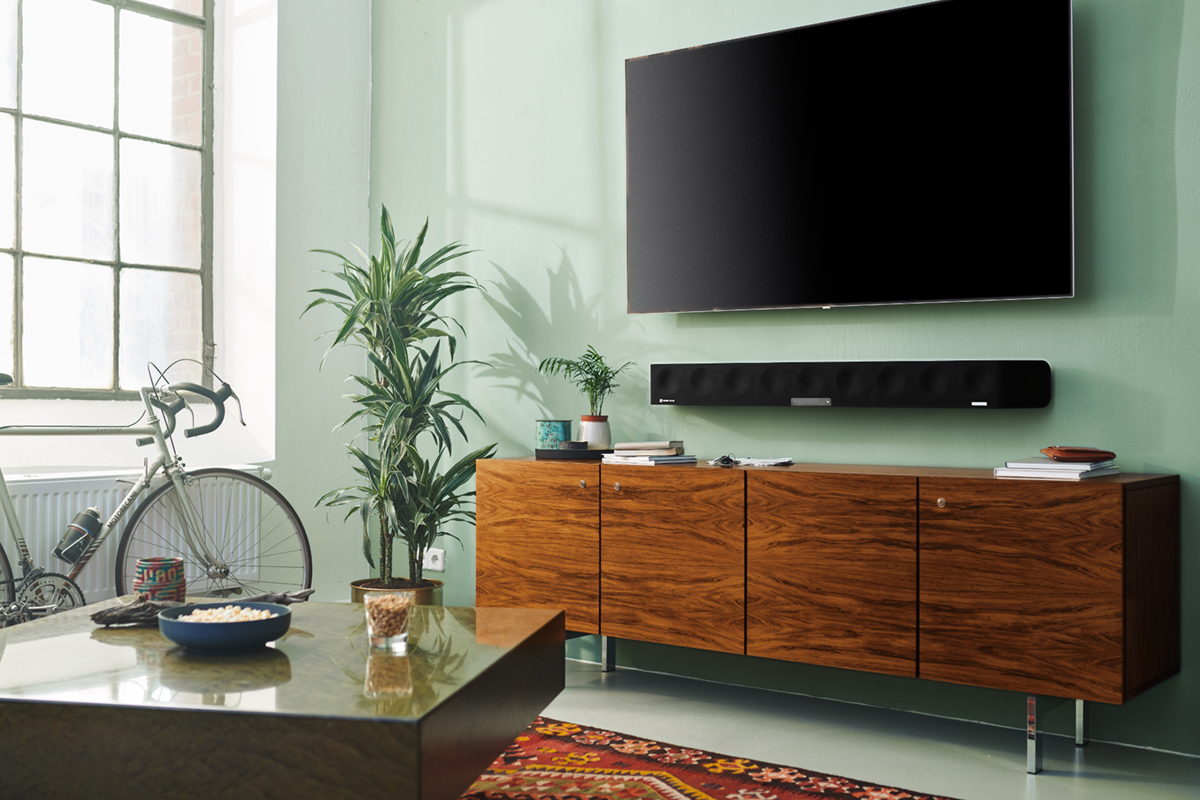
In louder scenes, the Ambeo better differentiated individual elements -- they were more mashed together through the Elacs. This may have had to do with the spatial unmasking effect I mentioned in the “Surround 101” section.
My experience was much the same with The Fifth Element. Through the Elacs, the big attack scene in the concert hall wasn’t as expansive as through the soundbar, but it was bigger and bolder, with lower distortion. Individual effects were more clearly unmasked by the Ambeo.
With Scott-Heron’s cover of Johnson’s “Me and the Devil,” the NAD-Elacs sounded more dynamic and less congested than the Sennheiser. The big percussion effects were crisper and hit way harder through the Elacs, and sounded less harsh. With “I’m New Here,” Pat Sullivan’s guitar sounded woodier and richer through the NAD-Elacs, and the strings had more metallic sheen.
With George Lepauw’s traversal of Bach’s Well-Tempered Clavier, the Elacs didn’t create as big a soundstage as the Sennheiser did with Ambeo processing enabled, yet the Elacs sounded truer. There was more reverberation through the Ambeo, but it sounded a bit artificial compared to the Elacs. Through the latter I had a much better sense that Lepauw was playing a big Steinway -- piano tone was fuller and more authoritative. The Elacs also more clearly reproduced the pianist’s touch and pedaling, letting me more fully appreciate his approach to these pieces.
Worth noting: The NAD-Elac system costs 2.5 times as much as the Ambeo. And while my system is fairly room-friendly, it’s not a one-piece solution.
Conclusion
At $2499.95, the Ambeo is the most expensive soundbar on the planet. I asked Sennheiser what led them to believe there was an appetite for such a product. Their reply: “We have watched consumers moving from full-fledged home-cinema systems into more simple and reduced soundbars. . . . Consumers hate complexity -- wires, etc. They are willing to compromise from an acoustics point-of-view, but only to a limited degree. We identified an area in which our premium customers had not yet found a product. This area sits between low complexity and a great hi-fi Dolby Atmos sound experience.”
SoundStage! has an Instagram feed on which we post photos of products we’re about to review. Recently, when we posted an image of the Ambeo set up on my living-room mantle, someone posted this comment: “I think it is insanity to pay $2500 USD for a soundbar.”
Is it? Lots of movie lovers live in homes where the notion of a full-blown Atmos system is completely crazy, yet they yearn for immersive, high-fidelity surround sound. And they want a system that performs well with music as well as movies. You can’t get that from a regular soundbar. You can with Sennheiser’s Ambeo.
. . . Gordon Brockhouse
Associated Equipment
- Display -- Samsung UN55LS003 55” The Frame UHD TV
- Sources -- Apple TV 4K, Samsung UMB-M7500 Ultra HD BD player, Apple Mac Mini computer running Roon Core 1.7, LG G7 ThinQ smartphone
- Active speakers -- Elac Navis ARF-51
- Streaming DAC-preamp -- NAD Classic C 658
- Control devices -- Apple iPad Mini 3, LG G7 ThinQ smartphone
- Network -- Google Wifi three-node mesh network
Sennheiser Ambeo Soundbar
Price: $2499.95 USD.
Warranty: Two years repair or replacement.
Sennheiser Electronic Corporation
1 Enterprise Drive
Old Lyme, CT 06371
Phone: (800) 736-6434
Website: www.sennheiser.com



